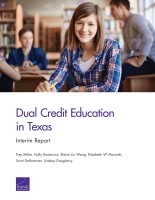| 来源类型 | Research Reports
|
| 规范类型 | 报告
|
| DOI | https://doi.org/10.7249/RR2043
|
| 来源ID | RR-2043-CFAT
|
| Dual Credit Education in Texas: Interim Report |
| Trey Miller; Holly Kosiewicz; Elaine Lin Wang; Elizabeth VP Marwah; Scott Delhommer; Lindsay Daugherty
|
| 发表日期 | 2017
|
| 出版年 | 2017
|
| 页码 | 122
|
| 语种 | 英语
|
| 结论 |
Four Main Findings (Based on Data from Before the Implementation of House Bill 505 in 2015)- DC students who graduated from high school had better college outcomes — including higher grades in DC courses and their follow-on courses; higher college enrollment, persistence, and completion rates; and lower remediation rates — than high school graduates who did not take DC courses.
- DC instruction and advising varied across colleges and universities.
- Disparities in DC participation rates — by race/ethnicity, income, urbanicity (the urban or rural location of the student's high school), gender, and academic background — exist and change across demographic groups over time. These disparities persist, and the research thus far is unable to pinpoint their specific causes.
- DC students took about the same number of semester credit hours (SCHs) as their non-DC counterparts, however, they took, on average, half an academic year less to complete a four-year degree.
Research Questions for the Second Phase of the Study- Are there systematic differences in curricula, course content, assessment methods and standards, and/or teaching approaches in DC and college-credit-only courses?
- Is there a way to improve DC advising to reduce the number of SCHs a DC student earns toward a college degree?
- How much did students' previous academic preparation and behavioral dispositions, versus what they learned in their DC courses, contribute to their academic success?
- What are the financial costs of DC programs to stakeholders, given that Texas allocates funding to both high schools and colleges and universities to deliver DC and that DC students exhibit similar time-to-degree and SCHs-to-degree patterns as college-credit-only students?
- Why do disparities in DC participation rates across demographic groups exist and persist?
- Are institutions expanding dual-credit programs in response to House Bill 505 If so, which students are gaining access to dual-credit education, and are they still benefiting?
|
| 摘要 |
- Policymakers should wait for findings from the next phase of the study to make changes to policy surrounding dual credit programs in Texas.
|
| 主题 | College-Bound Students
; Education Policy
; Educational Program Evaluation
; Postsecondary Education
; Secondary Education
; Texas
|
| URL | https://www.rand.org/pubs/research_reports/RR2043.html
|
| 来源智库 | RAND Corporation (United States)
|
| 引用统计 |
|
| 资源类型 | 智库出版物
|
| 条目标识符 | http://119.78.100.153/handle/2XGU8XDN/108551
|
推荐引用方式
GB/T 7714 |
Trey Miller,Holly Kosiewicz,Elaine Lin Wang,et al. Dual Credit Education in Texas: Interim Report. 2017.
|
|
文件名:
|
x1503943823733.jpg
|
|
格式:
|
JPEG
|

|
文件名:
|
RAND_RR2043.pdf
|
|
格式:
|
Adobe PDF
|
除非特别说明,本系统中所有内容都受版权保护,并保留所有权利。